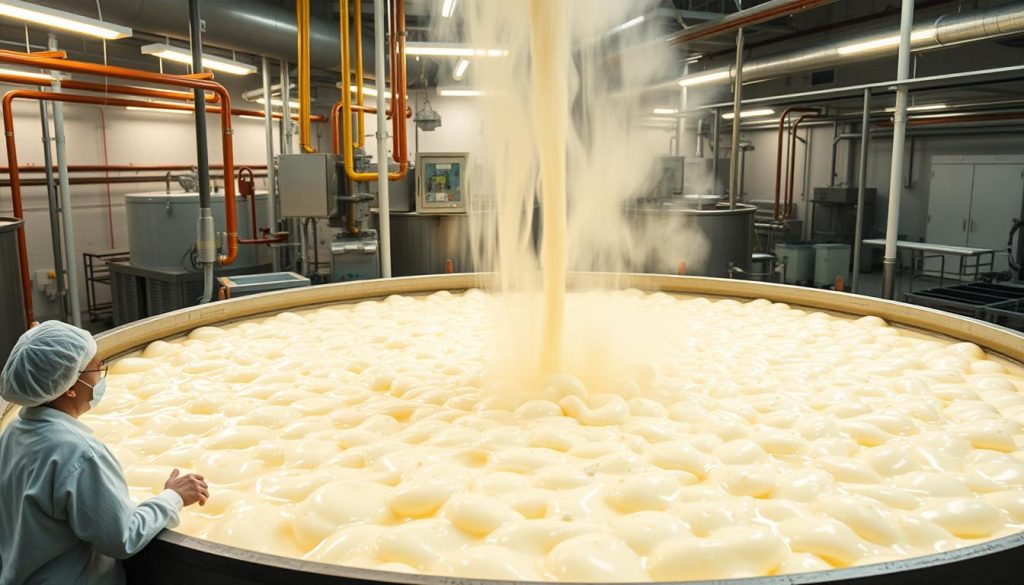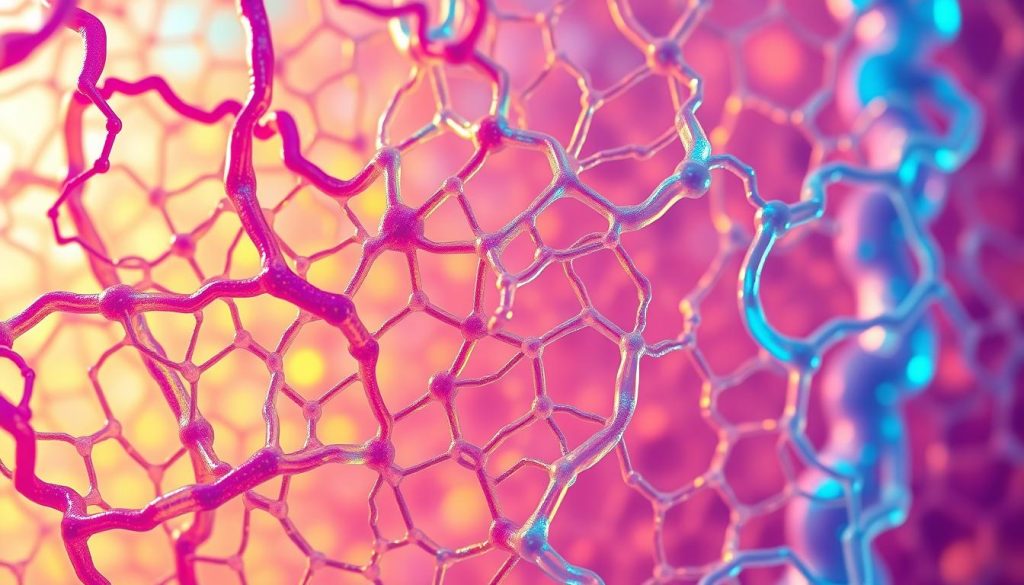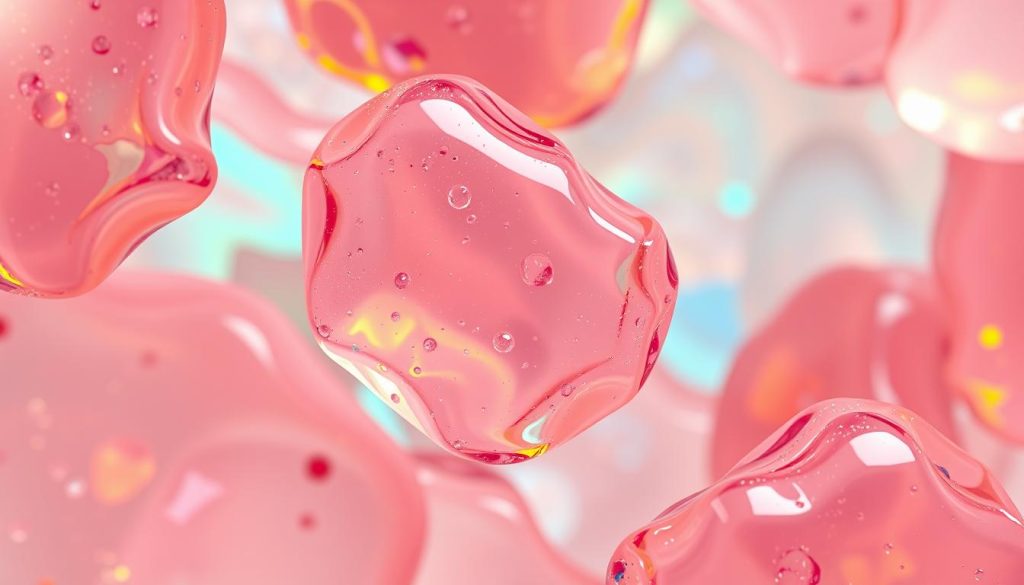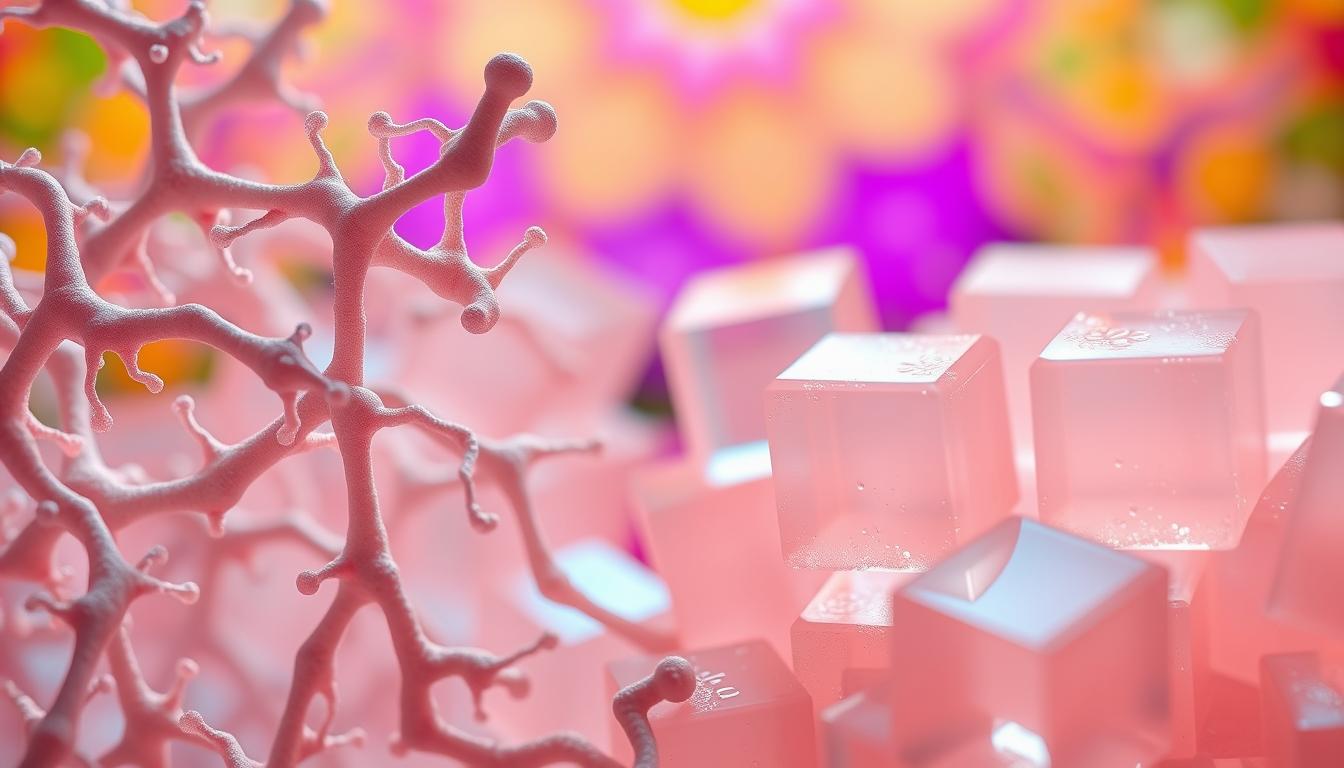Did you know 30% of your body’s protein comes from collagen? This powerhouse molecule forms the scaffolding of your skin, joints, and bones. Yet its lesser-known cousin, gelatin, often sparks confusion despite sharing the same biological roots.
Collagen occurs naturally in connective tissues, acting like glue that holds your body together. Gelatin emerges when collagen breaks down through cooking—think simmered bones or slow-cooked broths. While both contain identical amino acids, their structures differ enough to change how they work in supplements, foods, and beauty products.
Choosing between them depends on your goals. Collagen peptides dissolve easily in liquids, making them ideal for smoothies. Gelatin’s gelling properties shine in desserts or thick sauces. Both support skin elasticity and joint health, but their unique textures and applications mean they’re not always interchangeable.
Key Takeaways
- Collagen makes up 30% of your body’s protein, primarily in skin, joints, and bones
- Gelatin forms when collagen undergoes heat processing, altering its texture
- These proteins share amino acids but serve different practical purposes
- Collagen supplements blend easily, while gelatin works best for cooking
- Both support tissue health but aren’t always substitutes for each other
Understanding Collagen
Collagen isn’t just a buzzword—it’s your body’s architectural blueprint. This protein forms 30% of your body’s mass, acting as biological scaffolding in skin, tendons, and bones. Its triple helix structure gives tissues remarkable durability while maintaining flexibility.

Your Body’s Framework
Every movement relies on collagen’s unique properties. The triple helix configuration—three interwoven amino acid chains—creates tensile strength comparable to steel wire. This design allows your skin to stretch without tearing and joints to absorb impact.
Nutritional Powerhouse
Collagen supplements deliver glycine, proline, and hydroxyproline—amino acids rarely abundant in modern diets. Clinical trials show:
| Supplementation | Skin Moisture | Collagen Integrity |
|---|---|---|
| 10g daily for 8 weeks | +28% improvement | -31% fragmentation |
| 12-week regimen | Sustained results | Enhanced elasticity |
Age reduces natural collagen synthesis by 1% yearly after 25. Strategic supplementation helps maintain tissue resilience. Whether through bone broth or hydrolyzed peptides, consistent intake supports your body’s structural needs.
Understanding Gelatin
Your kitchen holds a hidden science experiment involving simmering bones and molecular transformation. This versatile protein forms when collagen undergoes controlled heat exposure, changing its structure while preserving nutritional value.

From Structural Protein to Culinary Tool
Slow-cooked animal bones release collagen strands that unravel during prolonged heating. This denaturation process breaks bonds between amino acids, creating shorter protein chains. The result? A substance that shifts between liquid and solid states based on temperature.
Traditional preparation methods require:
- 18+ hours of simmering connective tissues
- Constant low heat (160-180°F)
- Acidic components like vinegar to extract proteins
Mastering Texture in Recipes
Gelatin’s magic lies in its ability to form firm gels when cooled. Unlike collagen peptides, it demands hot water for proper dissolution. Chefs leverage this property to create:
| Application | Gelatin Use | Collagen Use |
|---|---|---|
| Desserts | Sets structure (jellies, mousse) | Not applicable |
| Soups/Sauces | Adds thickness | Blends invisibly |
| Supplements | Limited use | Easy mixing |
While both proteins come from the same source, gelatin’s gelling capacity makes it irreplaceable in baking. It enhances mouthfeel in broths without altering flavors—perfect for rich pho or velvety gravies.
What’s the Deal with Gelatin and Collagen?
Structural complexity determines how collagen and gelatin behave in your body and kitchen. Collagen’s triple helix configuration contains three tightly wound chains, each with 1,000+ amino acids. Gelatin forms when heat breaks these bonds, creating shorter protein strands through partial hydrolysis.

Breaking Down the Building Blocks
Hydrolyzed collagen peptides undergo intensive processing. Enzymes and steam pressure slice the massive molecules into fragments weighing under 5,000 daltons. This creates a powder that dissolves instantly in any liquid. Gelatin’s larger chains require hot water to activate and form temperature-sensitive gels.
| Property | Collagen Peptides | Gelatin |
|---|---|---|
| Molecular Weight | 2,000-5,000 Da | 50,000-100,000 Da |
| Solubility | Hot & Cold Liquids | Hot Liquids Only |
| Digestion Time | Absorbed in 1-2 Hours | Requires 4+ Hours |
| Common Uses | Supplements, Drinks | Desserts, Thickeners |
Optimizing Nutrient Delivery
Smaller collagen peptides bypass lengthy digestion. Your bloodstream absorbs them rapidly to support skin and joint repair. Gelatin’s bulkier chains need stomach acids to break them down, delaying nutrient availability by hours.
Both forms contain identical amino acids like glycine and proline. However, processing methods determine whether you get quick-acting support or culinary functionality. Choose peptides for daily supplementation and gelatin when texture matters most.
Health Benefits Comparison
Modern science reveals how these proteins deliver distinct yet overlapping advantages. Both support structural health through unique mechanisms, offering solutions for aging skin, creaky joints, and digestive concerns.

Visible Transformations Below the Surface
Your skin reaps rewards from collagen and gelatin supplementation. Fish-derived gelatin increased skin thickness by 18% and collagen density by 22% in year-long animal studies. Human trials show similar patterns:
| Benefit Type | Collagen Impact | Gelatin Impact |
|---|---|---|
| Skin Aging | +28% moisture retention | Improved elasticity |
| Joint Pain | Reduced inflammation | Enhanced mobility |
| Bone Density | Supports mineral absorption | Aids calcium binding |
Athletes using 10g collagen daily reported 67% less joint pain during high-impact activities. Osteoarthritis patients saw similar improvements with just 2g gelatin—proof both proteins deliver results through different pathways.
Beyond Physical Structure
Your gut lining benefits from these proteins’ amino acid profiles. Gelatin’s slower digestion creates a protective coating for intestinal walls. Collagen provides glycine and proline—key nutrients for maintaining tight junctions between gut cells.
Research suggests gelatin may edge out collagen for digestive support. Its gelling properties linger longer in the small intestine, potentially soothing irritation. Both forms stimulate your body’s natural collagen production, creating systemic benefits from scalp to toenails.
Choosing the Right Supplement for Your Goals
Your body absorbs collagen peptides and gelatin with equal efficiency, but their applications diverge sharply. Purpose determines which form delivers optimal results—whether you’re boosting protein intake or crafting textured dishes.
Supplementation for Nutritional Support
Collagen peptides dominate daily wellness routines. This powder dissolves instantly in coffee, smoothies, or oatmeal without altering texture. Precise dosing becomes effortless with pre-measured scoops and labeled nutritional profiles.
| Factor | Collagen Peptides | Gelatin |
|---|---|---|
| Daily Use | Effortless mixing | Requires heating |
| Protein Tracking | Exact measurements | Recipe-dependent |
| Versatility | All beverages | Heat-activated uses |
One serving provides 10g of protein that supports tendons and joints within hours. Athletes and busy professionals favor this form for consistent results.
Culinary Creations and Functional Uses
Gelatin transforms recipes through thermal responsiveness. Its gelling power makes homemade gummies firm and sauces velvety. Unlike collagen supplements, this type demands careful temperature control during preparation.
“Gelatin’s unique behavior in recipes makes it irreplaceable—no other plant-based thickener replicates its mouthfeel.”
Consider these applications:
- Jellies set faster with gelatin than agar-agar
- Broths gain body without cloudiness
- Desserts maintain shape at room temperature
While both products share amino acids, gelatin may better suit kitchen experiments. Collagen supplements remain superior for targeted nutritional support.
Conclusion
Navigating protein choices becomes clearer when recognizing how processing alters functionality. These twin proteins share identical amino acids but serve distinct roles based on preparation methods. Collagen’s rapid absorption makes it ideal for daily supplementation, while gelatin’s thermal responsiveness excels in culinary applications.
Your goals dictate which form to prioritize. Seek convenience? Hydrolyzed collagen blends seamlessly into drinks. Value texture control? Gelatin transforms desserts and broths without additives. Both support tissue repair, but their physical properties create different user experiences.
Remember: collagen shines in digestive support and quick nutrient delivery. Gelatin offers structural versatility for recipes needing gelling power. Pairing both can maximize benefits—enhance wellness routines with peptides and elevate cooking projects with traditional preparation methods.
Ultimately, understanding these differences empowers smarter nutritional choices. Match the protein’s strengths to your lifestyle for optimal results.



